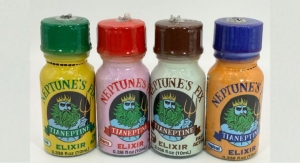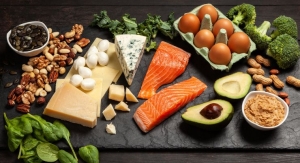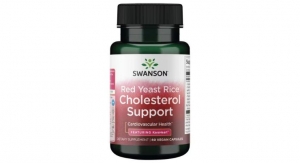Marian Zboraj07.01.07
Echinacea, schisandra, valerian, milk thistle and ginseng have all been used for centuries to treat everything from infections, stress and lack of sleep, to brain, heart and stomach conditions. Not much has changed over the years as today's consumers continue the tradition of using herbs and botanicals for numerous health issues. In fact, according to The Natural Marketing Institute's (NMI's) Health & Wellness Trends Database, more than four in 10 consumers indicate that they have used herbal supplements over the past year. Further, NMI claims the usage of herbal supplements has had compound annual growth increases of nearly 10% since 2003-this growth rate is second only to condition-specific supplements. The number of new product introductions for herbal supplements has also increased. In 2003, there were just over 25 new products introduced. That number increased to more than 140 in 2006.
Consumers have routinely obtained the nutritional benefits of herbs/ botanicals through tablets or capsules. However, as the market has become over saturated with these similar forms of delivery, many consumers have recently turned to foods and beverages for their herbal/botanical needs. Citing data from the International Food Information Council (IFIC), Paul Dijkstra, CEO, InterHealth Nutraceuticals, Inc., Benicia, CA, claims that more than 80% of Americans say they consume or are interested in consuming functional foods and beverages.
This popularity in convenient food and beverage forms has also combined with the trend of using herbs and botanicals for condition-specific purposes, as opposed to simply maintaining general health. Natural weight management, anti-inflammatory and cardiovascular support are among the major functional categories that consumers are demanding herbal/botanical solutions.
"This shift has given manufacturers many opportunities to develop new products that deliver the flexibility, variety and results that consumers want," said Mr. Dijkstra. "Consumers are looking for products that give them safe and effective results while not compromising on taste."
An example of a plant that is gaining recognition in weight management is cha de bugre. "Cha de bugre is a unique weight loss product from the rainforests of Brazil," said Jeff Lane, quality control manager, NP Nutra, Hawthorne, CA. "It gives a user the sense of being satisfied and full after eating only a small amount of food. This promotes eating smaller meals and keeps the metabolism going throughout the day."
According to Karen Gibbs, president, Nature's Thyme, LLC, Cedar Knolls, NJ, other popular entries include a�ai juice concentrates, mangosteen, goji, and even yacon syrup, which can be used as a replacement for sugar.
In terms of condition-specific trends, Marlene Siegel, founder, Ecuadorian Rainforest, Belleville, NJ, singled out herbs like ginger, boswellia and samambaia for making their mark on the industry due to their anti-inflammatory properties.
Another area experiencing growth is antioxidants, particularly in the supplement market. "We are finding that botanical-derived antioxidants are continuing to gain shelf space as manufacturer-marketers of dietary supplements reap tre-mendous resale in retail channels," said Charlene Lee, executive vice president and general manager, Cyvex Nutrition, Irvine, CA. "Antioxidants such as berries are extremely popular."
Also of significance is the continued growth of the "superfruits" category, which has spilled over into the beverage market. Beverages containing superfruits such as pomegranate and a�ai offer an attractive combination of health benefits and exotic tastes.
Speaking of exotic, this is another trend that has taken off in the herbal/botanical market. Ingredients from geographical niches in Asia, South America and North Africa are attracting consumer attention. As a result, Naturex, Avignon, France, is introducing new botanical extracts sourced from the mountains of Morocco, while Ecuadorian Rainforest continues work on a new botanical line called Exotic-a spotlight on South American raw materials that offer both health and cosmetic benefits to end users.
Organic materials are also in demand, with growth in this category soaring into the double digits, according to George Pontiakos, president and CEO, BI Nutra-ceuticals, Long Beach, CA. This is because consumers perceive organics as healthier, fresher-containing no pesticides or heavy metals. The limiting factor to organics, however, is the ability to grow enough products to support demand. And at the moment, demand is outstripping supply.
Ms. Gibbs has also noticed a huge surge in the area of organic vegetable powders. In fact, she says the amount of requestsfor these materials over the past several months alone has been overwhelming.
Overwhelming demand across the board for herbs/botanicals highlights the need for companies to take part in sustainable and ethical sourcing of plant materials. The Convention on International Trade in Endangered Species of Wild Fauna and Flora (CITES) was adopted in 1975 by 80 countries to serve as an international agreement "on regulation of export, transit and import of rare or threatened wildlife species." The American Herbal Products Association (AHPA), Silver Spring, MD, has taken an active role in attending CITES meetings to ensure that the herbal products industry's interests are considered and protected.
Other industry members doing their part include Naturex, which is a member of the United Nations Global Compact, the world's largest voluntary corporate responsibility initiative committed to respecting and promoting human rights, labor standards and the environment. Over the next few months, Naturex plans to launch the Naturex Foundationin order to promote the social development of the communities in which it sources raw materials.
As a result of the recent focus on FDA activity in the food/pet food area, the topic of adulteration is top of mind for everyone. Focusing specifically on the melamine scandal in the pet food market, it seems companies were willing to sacrifice quality for price. And some contend the same is true of dietary supplement companies.
Over the past few years, the high de-mand for dietary supplements has led to an influx of inferior raw material ingredients. Black cohosh, ginkgo and bilberry are just a few of the herbs that have suffered the consequences of adulteration.
But Mark Blumenthal, founder and executive director of the American Botanical Council (ABC), Austin, TX, wants to remind the industry that not all material coming from China is adulterated. "The problem is that it's hard to distinguish the quality of material unless it is run through appropriate analytical testing. But since the price of the material is very good, some companies don't want to perform these tests and they just look the other way."
Nature's Thyme's Ms. Gibbs says unless FDA cracks down on companies, consumers will ultimately suffer the consequences. "There is a lot of blending that does not get caught, and unless FDA cracks down on actual testing and identification of products, consumers will be in the dark as to what supplement they are taking," she said. To further guarantee that all products are what they are labeled to be, Ms. Gibbs recommends IR (infrared) spectrum testing for identification on all products and calls for standard tests for detection of other fillers like malto and glutens that are used to cut powders when they are imported from overseas.
Cecilia McCollum, executive vice president, Blue California, Rancho Santa Margarita, CA, hopes that recent concerns about adulterated Chinese products/ingredients will be a wake-up call for buyers in the industry to realize that price can't be the most important issue. "The greatest challenge for Blue California is not the science part of it, or maintaining GMP certification, it is the willingness of a segment in our industry to sacrifice quality for lower prices," she said. "Fortunately for us and the consumers, there are still companies out there in our industry that diligently test their raw materials, expect the highest quality and are willing to pay for consistent quality and value."
In agreement was Scott Rosenbush, bus-iness manager-Botanicals, P.L. Thomas Co., Morristown, NJ, who added that simply meeting "specs" is not enough. "Suppliers are being asked for detailed safety data well beyond an LD-50, such as acute and chronic toxicity and mutagenicity test results," he said.
Grace Villagomez, purchasing director, Ecuadorian Rainforest, says to ensure a high standard of quality for all products, everything from the sanitary conditions of the storage facility to the proper use of equipment must be controlled at all times.
But the bottom line is companies really need to know their raw material supplier. Knowing your partner and controlling the supply chain is critical to preventing adulteration issues. Partner with raw material suppliers that can guarantee quality products through supplier certification programs. "A CoA (Certificate of Analysis) should be provided with every shipment, listing the physical specifications of the product, test results for chemical and heavy metals content, microbiological testing, as well as the methods of analysis to scientifically validate how pure and safe each product is," said NP Nutra's Mr. Lane.
In the context of self-regulation, Bill Pine, vice president, Improve USA, DeSoto, TX, highlighted the aloe segment, which has already taken a proactive approach by instituting a certification procedure by the International Aloe Science Council (IASC). "The IASC seal of certification on a product is the consumer's as-surance that the product meets the statements on the label regarding the aloe content of the product," he said.
Stressing the importance of testing on all botanical processing for proper genus and species identification, Todd Norton, president, Sabinsa Corp., Payson, UT, explains that if such specialty is not available in house, there are outside laboratories that have expertise in performing these "fingerprint" tests. "Other parameters like residual solvents and pesticides also need to be factored in," he added. "There is an International Code of Harmonization Guideline where many countries have agreed to acceptable minimum levels of various solvents. Not many people know this exists or therefore follow it. This seems to be a good place to start." Mr. Norton also pointed out there are published guidelines on heavy metal contamination.
Ms. McCollum emphasized the necessity of testing finished products, and contract manufacturers being accountable for meeting label claims. "If companies only look at maximizing their profit, they are jeopardizing the integrity, safety and quality of their products," she said. "When a product fails to meet label claim, the responsibility lies with all parties involved, not just the supplier."
Herbs generally will require some form of sterilization to control microbial contamination, preferably through a method that minimally impacts the quality and efficacy of a product. Commercial viability, government regulations and consumer acceptance all influence the sterilization method chosen. And as BI's Mr. Pontiakos explains, ethylene oxide (ETO) and irradiation are no longer used to reduce microbial counts.
"Treatment with ETO has been shown to be very effective in reducing microbial load in herb products, but due to environmental concerns it has been banned throughout Europe," said Mr. Pontiakos. "In the U.S., it is not legally allowed to be used on dietary supplements, and doing so renders the product adulterated under the Food, Drug and Cosmetic Act (FDCA)."
Mr. Pontiakos also discussed gamma-irradiation as another effective method of reducing microbial loads, but like ETO it is prohibited in Europe, and in the U.S. it is restricted to use on very few crops. Similar to ETO, treatment of herb products with gamma-irradiation renders the material adulterated under the FDCA. This treatment method is also not permitted on certified organic products, and there is increasing concern with the processes of such treatment and long-term environmental impacts.
Steam, heat and ozone are alternatives currently in use by the industry to eliminate the use of ETO and irradiation. Last year, BI Nutraceuticals introduced Protexx HP, a unique steam sterilization process for the company's line of herbal powders that uses super-heated dry steam to reduce microbiological load, with results comparable to that of treatment with ETO or irradiation without the potential regulatory issues. According to BI, Protexx HP delivers maximum reduction in potential contaminants, while preserving color, flavor and bioactive components. Steam sterilization does not have any residual impact on herbal materials, and the process is acceptable for the treatment of certified organic products.
Sabinsa, on the other hand, uses SCFE (Super Critical Fluid Extraction) to ensure environmentally friendly "solvent free" extracts, as well as to guarantee low microbial loads so no irradiation is needed.
"Limitations or restrictions on such sterilization methods as irradiation and ETO, along with changes in consumer trends, may lead companies to seek alternative means of supplying products that meet these criteria," said Mr. Pontiakos. "Acceptance by consumers of different treatment methods is evolving to a point where there is a greater demand for products that fulfill their increasing requirement for 'healthy and natural foods,' in addition to herbs that are considered 'safe' without compromising quality or efficacy."
Besides new advances in sterilization, there have been improvements in dosage compliance and flavor masking thanks to the benefits of microencapsulation. Microencapsulation is a process allowing the coating of a solid particle or droplet of liquid with a thin layer of chemically unrelated, often inert, material.
Companies like Blue California are using microencapsulation to produce in-novative ingredients, such as its new Vita-Sterols 40% soluble plant sterols for cholesterol control. Blue California has also produced deodorized and water-soluble valerian, making it effective and palatable.
"Microencapsulation can be indispensable to different ingredients of a dosage form when there is a possibility of undesirable chemical interaction between them, or to insulate from the environment ingredients that are known to be oxygen or moisture sensitive," Mr. Pontiakos commented. "The size of coated particles or droplets obtained by this technique can range from a few microns to several millimeters. In its ideal form, a microcapsule can be represented by a spherical particle with a uniform wall around it. The material inside the microcapsule is referred to as the core, internal phase or fill, whereas the wall is sometimes called a shell, coating or membrane."
Microencapsulated particles actually have a variety of forms and shapes and often may consist of clusters of micro- and macro-particles "glued" together by their shells. This latter kind of microencapsulation is often utilized when the initial material in the form of powder is being worked into granular substance suited for further compression into tablets and pills. The goal of microencapsulation may be as simple as masking the taste or odor of the core, or as complex as increasing the selectivity of an adsorption or extraction process-the applications are endless.
In one of BI Nutraceuticals' new sustained release products, the water sensitive core particle is consequently coated with two different kinds of cellulose derivatives-first with an alcohol soluble and then with a water soluble. The tablet made from the resulting granular product disintegrates in aqueous medium and then slowly releases the active ingredients in the course of several hours.
The big news in the market today is the impending release final GMPs from FDA, which will provide specific standards to check for purity, safety and legality in manufacturing. This development should have a positive impact on the herbs/botanicals market, which has been plagued by the quality issues of some substandard products. Not only has this issue eroded consumer confidence, but physicians and healthcare professionals' trust in herbal products has also suffered because they believe the industry to be "unregulated."
"The fact is, all herbal dietary supplement ingredients are considered food under the law and therefore are currently regulated by the Food GMPs," said ABC's Mr. Blumenthal, adding, "but without the new Dietary Supplement GMPs in place all these years, a lot of people have taken advantage of the opportunity to put out substandard products, either intentionally or unintentionally." Mr. Blumenthal ex-pects the final dietary supplement GMPs to be much more stringent in terms of analysis of the raw material and of the finished goods.
With regard to the growing interest in functional food delivery, Mr. Rosenbush of PL Thomas believes raw material suppliers and many of the food manufacturers still need to come up to speed with the significantly different regulatory environment for foods. "Many of our 'grandfathered' herbal ingredients under DSHEA are not allowed in traditional food products where some type of GRAS (generally recognized as safe) status is required," he said.
In other regulatory developments, Mr. Blumenthal makes note of the importance of Congress recently passing the adverse event reporting (AER) bill, which makes it mandatory for supplement companies to report serious adverse events to FDA. As such, all finished products by the end of this year must be sold with revised labeling that gives consumers and physicians a toll free number or another way to reach a company in the event of an adverse reaction.
"I suspect we are not going to see a lot of reports of serious adverse events and I think this presumed lack of reports is going to become a validation of the relative safety of herbal products," Mr. Blumenthal said. The downside, he pointed out, is that some people may make reports that are not serious as defined by law (serious meaning a trip to the emergency room or hospitalization).
Mr. Blumenthal went on to say that he feels the AER database must be set up to avoid including reports of non-serious adverse events or unqualified reports; or if they are included, that they are appropriately identified as a non-serious event. "If a mother calls the number because her child swallowed the cotton from a vitamin bottle, then that would be considered an 'exposure' claim related to the product, not a serious adverse event. We have to avoid people presuming that such reports are all adverse and in turn, misinterpreting the data and statistics relating to AERs."
Asked about the future of the herbs/botanicals market, some experts believe the recent recalls by the drug industry will encourage many consumers to search for a more natural approach to their health. Following this theory, InterHealth's Mr. Dijkstra predicts the greatest opportunities lie where there are few or no acceptable long-term OTC or pharmaceutical options-where the product causes side effects or is cost-prohibitive. If companies expect to reach these consumers, however, research will need to be much a part of the equation.
Antoine Dauby, marketing manager, Naturex, however, expects new and sophisticated product development to remain an essential way to gain significant market share. As a result, he said the herbs/botanicals category would more than likely evolve into a more mature state with more science-based products to support claims.
BI's Mr. Pontiakos expressed a similar point of view, suggesting that in order for the industry to be more aggressive about the benefits of herbs/botanicals, it must invest in more studies and support the scientific community.
An important evolution in scientific support came recently when the National Institutes of Health (NIH) Office of Dietary Supplements presented Iowa State University (ISU) a grant to investigate three popular botanicals.
"The primary goal of the Iowa Center for Research on Botanical Dietary Supplements is to better understand the biological effects of bioactive constituents in three plants-echinacea, hypericum and prunella-and to identify potential health benefits of these dietary supplement ingredients," said Christine Swanson, PhD, MPH, director, Botanical Research Center Program, NIH Office of Dietary Supplements. "The center's research is focused on antiviral, anti-inflammatory and pain receptor mediated anti-inflammatory activity." The work conducted by the center includes basic and mechanistic research that will inform future clinical studies.
The botanical test materials developed by the Iowa investigators will be both chemically and biologically characterized. "In addition, the center has set an ambitious but achievable goal of optimizing the chemical composition of botanicals for use in clinical trials," said Dr. Swanson. "I expect that future clinical trials based on the basic research conducted by the Iowa center will have a high chance of success and produce results that can be replicated by other investigators."
Other recently completed studies have shown the potential health benefits of flaxseed and American ginseng. In the recent flaxseed study, led by Duke University Medical Center researchers, flaxseed was found to be effective in halting pros-tate tumor growth. The seed, which is similar to a sesame seed, may be able to interrupt the chain of events that leads cells to divide irregularly and become cancerous.
The multi-site study, which was funded by NIH, also involved researchers at the University of Michigan and the University of North Carolina, Chapel Hill. In the study, the researchers examined the effects of flaxseed supplementation on men who were scheduled to undergo prostatectomy-surgery for the treatment of prostate cancer. The men took 30 grams of flaxseed daily for an average of 30 days prior to surgery. Once the men's tumors were re-moved, the researchers looked at tumor cells under a microscope, and were able to determine how quickly the cancer cells had multiplied.
Men taking flaxseed, either alone or in conjunction with a low-fat diet, were compared to men assigned to just a low-fat diet, as well as to men in a control group, who did not alter or supplement their daily diet. Men in both flaxseed groups had the slowest rate of tumor growth. Each group was made up of about 40 participants. The researchers hope to next test the effectiveness of flaxseed supplementation in patients with recurrent prostate cancer, and ultimately to study its role as a preventative agent.
With regard to ginseng, researchers from the North Central Cancer Treatment Group (NCCTG), based at the Mayo Clinic in Rochester, MN, have generated preliminary data suggesting that a form of American ginseng may provide greater improvements in fatigue and vitality in cancer patients. This pilot study is the first to evaluate the Wisconsin species of American ginseng as a possible therapy for cancer-related fatigue.
Many cancer patients face extreme fatigue after diagnosis and during treatment. Traditional Chinese Medicine (TCM) and current understanding of ginseng's function both point to its characteristics as an adaptogen-a substance that helps the body overcome the effects of environmental stress. Since cancer patients have stressors ranging from the psychological stress of diagnosis to the physiological stresses of chemotherapy and radiation, if ginseng helps, the researchers think it would be a valuable addition to currently available therapies.
The investigators enrolled 282 patients and studied them using a randomized, placebo-controlled design, including 71 patients in each of the four arms-between 39 and 48 patients in each arm completed the 8 weeks of treatment. Treatment arms consisted of placebo, and three different daily doses of Wisconsin ginseng-750 mg, 1000 mg and 2000 mg. Of the four treatment arms, patients receiving the placebo and the lowest dose of ginseng reported very little improvement in fatigue or other areas of physical or psychological well-being. However, patients receiving the larger doses showed improvements in overall energy levels, reporting higher vitality levels and less interference with activity from fatigue. They also reported an improvement in overall mental, physical, spiritual and emotional well-being. While results are promising for this pilot study, researchers said more studies need to be conducted.
It is this type of research, combined with unique technology and science that can successfully differentiate products in the marketplace, which ABC's Mr. Blumenthal believes is crucial to the industry's future. "With new technology comes new types of preparations and thus new uses, in turn providing new remedies for the consumer," he said. "It all comes down to benefiting the consumer."
Budding Opportunities
Consumers have routinely obtained the nutritional benefits of herbs/ botanicals through tablets or capsules. However, as the market has become over saturated with these similar forms of delivery, many consumers have recently turned to foods and beverages for their herbal/botanical needs. Citing data from the International Food Information Council (IFIC), Paul Dijkstra, CEO, InterHealth Nutraceuticals, Inc., Benicia, CA, claims that more than 80% of Americans say they consume or are interested in consuming functional foods and beverages.
This popularity in convenient food and beverage forms has also combined with the trend of using herbs and botanicals for condition-specific purposes, as opposed to simply maintaining general health. Natural weight management, anti-inflammatory and cardiovascular support are among the major functional categories that consumers are demanding herbal/botanical solutions.
"This shift has given manufacturers many opportunities to develop new products that deliver the flexibility, variety and results that consumers want," said Mr. Dijkstra. "Consumers are looking for products that give them safe and effective results while not compromising on taste."
An example of a plant that is gaining recognition in weight management is cha de bugre. "Cha de bugre is a unique weight loss product from the rainforests of Brazil," said Jeff Lane, quality control manager, NP Nutra, Hawthorne, CA. "It gives a user the sense of being satisfied and full after eating only a small amount of food. This promotes eating smaller meals and keeps the metabolism going throughout the day."
According to Karen Gibbs, president, Nature's Thyme, LLC, Cedar Knolls, NJ, other popular entries include a�ai juice concentrates, mangosteen, goji, and even yacon syrup, which can be used as a replacement for sugar.
In terms of condition-specific trends, Marlene Siegel, founder, Ecuadorian Rainforest, Belleville, NJ, singled out herbs like ginger, boswellia and samambaia for making their mark on the industry due to their anti-inflammatory properties.
Another area experiencing growth is antioxidants, particularly in the supplement market. "We are finding that botanical-derived antioxidants are continuing to gain shelf space as manufacturer-marketers of dietary supplements reap tre-mendous resale in retail channels," said Charlene Lee, executive vice president and general manager, Cyvex Nutrition, Irvine, CA. "Antioxidants such as berries are extremely popular."
Also of significance is the continued growth of the "superfruits" category, which has spilled over into the beverage market. Beverages containing superfruits such as pomegranate and a�ai offer an attractive combination of health benefits and exotic tastes.
Speaking of exotic, this is another trend that has taken off in the herbal/botanical market. Ingredients from geographical niches in Asia, South America and North Africa are attracting consumer attention. As a result, Naturex, Avignon, France, is introducing new botanical extracts sourced from the mountains of Morocco, while Ecuadorian Rainforest continues work on a new botanical line called Exotic-a spotlight on South American raw materials that offer both health and cosmetic benefits to end users.
Organic materials are also in demand, with growth in this category soaring into the double digits, according to George Pontiakos, president and CEO, BI Nutra-ceuticals, Long Beach, CA. This is because consumers perceive organics as healthier, fresher-containing no pesticides or heavy metals. The limiting factor to organics, however, is the ability to grow enough products to support demand. And at the moment, demand is outstripping supply.
Ms. Gibbs has also noticed a huge surge in the area of organic vegetable powders. In fact, she says the amount of requestsfor these materials over the past several months alone has been overwhelming.
Overwhelming demand across the board for herbs/botanicals highlights the need for companies to take part in sustainable and ethical sourcing of plant materials. The Convention on International Trade in Endangered Species of Wild Fauna and Flora (CITES) was adopted in 1975 by 80 countries to serve as an international agreement "on regulation of export, transit and import of rare or threatened wildlife species." The American Herbal Products Association (AHPA), Silver Spring, MD, has taken an active role in attending CITES meetings to ensure that the herbal products industry's interests are considered and protected.
Other industry members doing their part include Naturex, which is a member of the United Nations Global Compact, the world's largest voluntary corporate responsibility initiative committed to respecting and promoting human rights, labor standards and the environment. Over the next few months, Naturex plans to launch the Naturex Foundationin order to promote the social development of the communities in which it sources raw materials.
Overcoming Adulteration Issues
As a result of the recent focus on FDA activity in the food/pet food area, the topic of adulteration is top of mind for everyone. Focusing specifically on the melamine scandal in the pet food market, it seems companies were willing to sacrifice quality for price. And some contend the same is true of dietary supplement companies.
Over the past few years, the high de-mand for dietary supplements has led to an influx of inferior raw material ingredients. Black cohosh, ginkgo and bilberry are just a few of the herbs that have suffered the consequences of adulteration.
But Mark Blumenthal, founder and executive director of the American Botanical Council (ABC), Austin, TX, wants to remind the industry that not all material coming from China is adulterated. "The problem is that it's hard to distinguish the quality of material unless it is run through appropriate analytical testing. But since the price of the material is very good, some companies don't want to perform these tests and they just look the other way."
Nature's Thyme's Ms. Gibbs says unless FDA cracks down on companies, consumers will ultimately suffer the consequences. "There is a lot of blending that does not get caught, and unless FDA cracks down on actual testing and identification of products, consumers will be in the dark as to what supplement they are taking," she said. To further guarantee that all products are what they are labeled to be, Ms. Gibbs recommends IR (infrared) spectrum testing for identification on all products and calls for standard tests for detection of other fillers like malto and glutens that are used to cut powders when they are imported from overseas.
Cecilia McCollum, executive vice president, Blue California, Rancho Santa Margarita, CA, hopes that recent concerns about adulterated Chinese products/ingredients will be a wake-up call for buyers in the industry to realize that price can't be the most important issue. "The greatest challenge for Blue California is not the science part of it, or maintaining GMP certification, it is the willingness of a segment in our industry to sacrifice quality for lower prices," she said. "Fortunately for us and the consumers, there are still companies out there in our industry that diligently test their raw materials, expect the highest quality and are willing to pay for consistent quality and value."
In agreement was Scott Rosenbush, bus-iness manager-Botanicals, P.L. Thomas Co., Morristown, NJ, who added that simply meeting "specs" is not enough. "Suppliers are being asked for detailed safety data well beyond an LD-50, such as acute and chronic toxicity and mutagenicity test results," he said.
Grace Villagomez, purchasing director, Ecuadorian Rainforest, says to ensure a high standard of quality for all products, everything from the sanitary conditions of the storage facility to the proper use of equipment must be controlled at all times.
But the bottom line is companies really need to know their raw material supplier. Knowing your partner and controlling the supply chain is critical to preventing adulteration issues. Partner with raw material suppliers that can guarantee quality products through supplier certification programs. "A CoA (Certificate of Analysis) should be provided with every shipment, listing the physical specifications of the product, test results for chemical and heavy metals content, microbiological testing, as well as the methods of analysis to scientifically validate how pure and safe each product is," said NP Nutra's Mr. Lane.
In the context of self-regulation, Bill Pine, vice president, Improve USA, DeSoto, TX, highlighted the aloe segment, which has already taken a proactive approach by instituting a certification procedure by the International Aloe Science Council (IASC). "The IASC seal of certification on a product is the consumer's as-surance that the product meets the statements on the label regarding the aloe content of the product," he said.
Stressing the importance of testing on all botanical processing for proper genus and species identification, Todd Norton, president, Sabinsa Corp., Payson, UT, explains that if such specialty is not available in house, there are outside laboratories that have expertise in performing these "fingerprint" tests. "Other parameters like residual solvents and pesticides also need to be factored in," he added. "There is an International Code of Harmonization Guideline where many countries have agreed to acceptable minimum levels of various solvents. Not many people know this exists or therefore follow it. This seems to be a good place to start." Mr. Norton also pointed out there are published guidelines on heavy metal contamination.
Ms. McCollum emphasized the necessity of testing finished products, and contract manufacturers being accountable for meeting label claims. "If companies only look at maximizing their profit, they are jeopardizing the integrity, safety and quality of their products," she said. "When a product fails to meet label claim, the responsibility lies with all parties involved, not just the supplier."
Advances in Sterilization & Microencapsulation
Herbs generally will require some form of sterilization to control microbial contamination, preferably through a method that minimally impacts the quality and efficacy of a product. Commercial viability, government regulations and consumer acceptance all influence the sterilization method chosen. And as BI's Mr. Pontiakos explains, ethylene oxide (ETO) and irradiation are no longer used to reduce microbial counts.
"Treatment with ETO has been shown to be very effective in reducing microbial load in herb products, but due to environmental concerns it has been banned throughout Europe," said Mr. Pontiakos. "In the U.S., it is not legally allowed to be used on dietary supplements, and doing so renders the product adulterated under the Food, Drug and Cosmetic Act (FDCA)."
Mr. Pontiakos also discussed gamma-irradiation as another effective method of reducing microbial loads, but like ETO it is prohibited in Europe, and in the U.S. it is restricted to use on very few crops. Similar to ETO, treatment of herb products with gamma-irradiation renders the material adulterated under the FDCA. This treatment method is also not permitted on certified organic products, and there is increasing concern with the processes of such treatment and long-term environmental impacts.
Steam, heat and ozone are alternatives currently in use by the industry to eliminate the use of ETO and irradiation. Last year, BI Nutraceuticals introduced Protexx HP, a unique steam sterilization process for the company's line of herbal powders that uses super-heated dry steam to reduce microbiological load, with results comparable to that of treatment with ETO or irradiation without the potential regulatory issues. According to BI, Protexx HP delivers maximum reduction in potential contaminants, while preserving color, flavor and bioactive components. Steam sterilization does not have any residual impact on herbal materials, and the process is acceptable for the treatment of certified organic products.
Sabinsa, on the other hand, uses SCFE (Super Critical Fluid Extraction) to ensure environmentally friendly "solvent free" extracts, as well as to guarantee low microbial loads so no irradiation is needed.
"Limitations or restrictions on such sterilization methods as irradiation and ETO, along with changes in consumer trends, may lead companies to seek alternative means of supplying products that meet these criteria," said Mr. Pontiakos. "Acceptance by consumers of different treatment methods is evolving to a point where there is a greater demand for products that fulfill their increasing requirement for 'healthy and natural foods,' in addition to herbs that are considered 'safe' without compromising quality or efficacy."
Besides new advances in sterilization, there have been improvements in dosage compliance and flavor masking thanks to the benefits of microencapsulation. Microencapsulation is a process allowing the coating of a solid particle or droplet of liquid with a thin layer of chemically unrelated, often inert, material.
Companies like Blue California are using microencapsulation to produce in-novative ingredients, such as its new Vita-Sterols 40% soluble plant sterols for cholesterol control. Blue California has also produced deodorized and water-soluble valerian, making it effective and palatable.
"Microencapsulation can be indispensable to different ingredients of a dosage form when there is a possibility of undesirable chemical interaction between them, or to insulate from the environment ingredients that are known to be oxygen or moisture sensitive," Mr. Pontiakos commented. "The size of coated particles or droplets obtained by this technique can range from a few microns to several millimeters. In its ideal form, a microcapsule can be represented by a spherical particle with a uniform wall around it. The material inside the microcapsule is referred to as the core, internal phase or fill, whereas the wall is sometimes called a shell, coating or membrane."
Microencapsulated particles actually have a variety of forms and shapes and often may consist of clusters of micro- and macro-particles "glued" together by their shells. This latter kind of microencapsulation is often utilized when the initial material in the form of powder is being worked into granular substance suited for further compression into tablets and pills. The goal of microencapsulation may be as simple as masking the taste or odor of the core, or as complex as increasing the selectivity of an adsorption or extraction process-the applications are endless.
In one of BI Nutraceuticals' new sustained release products, the water sensitive core particle is consequently coated with two different kinds of cellulose derivatives-first with an alcohol soluble and then with a water soluble. The tablet made from the resulting granular product disintegrates in aqueous medium and then slowly releases the active ingredients in the course of several hours.
Improved Regulations Close at Hand
The big news in the market today is the impending release final GMPs from FDA, which will provide specific standards to check for purity, safety and legality in manufacturing. This development should have a positive impact on the herbs/botanicals market, which has been plagued by the quality issues of some substandard products. Not only has this issue eroded consumer confidence, but physicians and healthcare professionals' trust in herbal products has also suffered because they believe the industry to be "unregulated."
"The fact is, all herbal dietary supplement ingredients are considered food under the law and therefore are currently regulated by the Food GMPs," said ABC's Mr. Blumenthal, adding, "but without the new Dietary Supplement GMPs in place all these years, a lot of people have taken advantage of the opportunity to put out substandard products, either intentionally or unintentionally." Mr. Blumenthal ex-pects the final dietary supplement GMPs to be much more stringent in terms of analysis of the raw material and of the finished goods.
With regard to the growing interest in functional food delivery, Mr. Rosenbush of PL Thomas believes raw material suppliers and many of the food manufacturers still need to come up to speed with the significantly different regulatory environment for foods. "Many of our 'grandfathered' herbal ingredients under DSHEA are not allowed in traditional food products where some type of GRAS (generally recognized as safe) status is required," he said.
In other regulatory developments, Mr. Blumenthal makes note of the importance of Congress recently passing the adverse event reporting (AER) bill, which makes it mandatory for supplement companies to report serious adverse events to FDA. As such, all finished products by the end of this year must be sold with revised labeling that gives consumers and physicians a toll free number or another way to reach a company in the event of an adverse reaction.
"I suspect we are not going to see a lot of reports of serious adverse events and I think this presumed lack of reports is going to become a validation of the relative safety of herbal products," Mr. Blumenthal said. The downside, he pointed out, is that some people may make reports that are not serious as defined by law (serious meaning a trip to the emergency room or hospitalization).
Mr. Blumenthal went on to say that he feels the AER database must be set up to avoid including reports of non-serious adverse events or unqualified reports; or if they are included, that they are appropriately identified as a non-serious event. "If a mother calls the number because her child swallowed the cotton from a vitamin bottle, then that would be considered an 'exposure' claim related to the product, not a serious adverse event. We have to avoid people presuming that such reports are all adverse and in turn, misinterpreting the data and statistics relating to AERs."
Cultivating the Market's Future through Research
Asked about the future of the herbs/botanicals market, some experts believe the recent recalls by the drug industry will encourage many consumers to search for a more natural approach to their health. Following this theory, InterHealth's Mr. Dijkstra predicts the greatest opportunities lie where there are few or no acceptable long-term OTC or pharmaceutical options-where the product causes side effects or is cost-prohibitive. If companies expect to reach these consumers, however, research will need to be much a part of the equation.
Antoine Dauby, marketing manager, Naturex, however, expects new and sophisticated product development to remain an essential way to gain significant market share. As a result, he said the herbs/botanicals category would more than likely evolve into a more mature state with more science-based products to support claims.
BI's Mr. Pontiakos expressed a similar point of view, suggesting that in order for the industry to be more aggressive about the benefits of herbs/botanicals, it must invest in more studies and support the scientific community.
An important evolution in scientific support came recently when the National Institutes of Health (NIH) Office of Dietary Supplements presented Iowa State University (ISU) a grant to investigate three popular botanicals.
"The primary goal of the Iowa Center for Research on Botanical Dietary Supplements is to better understand the biological effects of bioactive constituents in three plants-echinacea, hypericum and prunella-and to identify potential health benefits of these dietary supplement ingredients," said Christine Swanson, PhD, MPH, director, Botanical Research Center Program, NIH Office of Dietary Supplements. "The center's research is focused on antiviral, anti-inflammatory and pain receptor mediated anti-inflammatory activity." The work conducted by the center includes basic and mechanistic research that will inform future clinical studies.
The botanical test materials developed by the Iowa investigators will be both chemically and biologically characterized. "In addition, the center has set an ambitious but achievable goal of optimizing the chemical composition of botanicals for use in clinical trials," said Dr. Swanson. "I expect that future clinical trials based on the basic research conducted by the Iowa center will have a high chance of success and produce results that can be replicated by other investigators."
Other recently completed studies have shown the potential health benefits of flaxseed and American ginseng. In the recent flaxseed study, led by Duke University Medical Center researchers, flaxseed was found to be effective in halting pros-tate tumor growth. The seed, which is similar to a sesame seed, may be able to interrupt the chain of events that leads cells to divide irregularly and become cancerous.
The multi-site study, which was funded by NIH, also involved researchers at the University of Michigan and the University of North Carolina, Chapel Hill. In the study, the researchers examined the effects of flaxseed supplementation on men who were scheduled to undergo prostatectomy-surgery for the treatment of prostate cancer. The men took 30 grams of flaxseed daily for an average of 30 days prior to surgery. Once the men's tumors were re-moved, the researchers looked at tumor cells under a microscope, and were able to determine how quickly the cancer cells had multiplied.
Men taking flaxseed, either alone or in conjunction with a low-fat diet, were compared to men assigned to just a low-fat diet, as well as to men in a control group, who did not alter or supplement their daily diet. Men in both flaxseed groups had the slowest rate of tumor growth. Each group was made up of about 40 participants. The researchers hope to next test the effectiveness of flaxseed supplementation in patients with recurrent prostate cancer, and ultimately to study its role as a preventative agent.
With regard to ginseng, researchers from the North Central Cancer Treatment Group (NCCTG), based at the Mayo Clinic in Rochester, MN, have generated preliminary data suggesting that a form of American ginseng may provide greater improvements in fatigue and vitality in cancer patients. This pilot study is the first to evaluate the Wisconsin species of American ginseng as a possible therapy for cancer-related fatigue.
Many cancer patients face extreme fatigue after diagnosis and during treatment. Traditional Chinese Medicine (TCM) and current understanding of ginseng's function both point to its characteristics as an adaptogen-a substance that helps the body overcome the effects of environmental stress. Since cancer patients have stressors ranging from the psychological stress of diagnosis to the physiological stresses of chemotherapy and radiation, if ginseng helps, the researchers think it would be a valuable addition to currently available therapies.
The investigators enrolled 282 patients and studied them using a randomized, placebo-controlled design, including 71 patients in each of the four arms-between 39 and 48 patients in each arm completed the 8 weeks of treatment. Treatment arms consisted of placebo, and three different daily doses of Wisconsin ginseng-750 mg, 1000 mg and 2000 mg. Of the four treatment arms, patients receiving the placebo and the lowest dose of ginseng reported very little improvement in fatigue or other areas of physical or psychological well-being. However, patients receiving the larger doses showed improvements in overall energy levels, reporting higher vitality levels and less interference with activity from fatigue. They also reported an improvement in overall mental, physical, spiritual and emotional well-being. While results are promising for this pilot study, researchers said more studies need to be conducted.
It is this type of research, combined with unique technology and science that can successfully differentiate products in the marketplace, which ABC's Mr. Blumenthal believes is crucial to the industry's future. "With new technology comes new types of preparations and thus new uses, in turn providing new remedies for the consumer," he said. "It all comes down to benefiting the consumer."



























